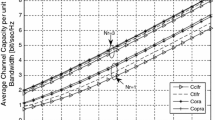Abstract
This paper presents joint source channel variable length (VL) coding/decoding based on a space trellis. Through constructing a joint decoding plane trellis, better decoding performance can be achieved than by using the bit-level decoding algorithm. However, the plane trellis is complicated, which results in high decoding complexity for decoding VL turbo codes. To solve this problem, we construct a space trellis and design a low-complexity joint decoding algorithm with a variable length symbol-a posteriori probability (VLS-APP) algorithm in resource constrained deep space communication networks. Simulation results show that the proposed approach reduces the decoding complexity by 10% compared with the plane trellis, and the gain of E b /N 0 is about 0.2 dB at SER = 10−4. Furthermore, it provides substantial error protection for variable-length encoded image data.
Similar content being viewed by others
References
Bauer R, Hagenauer J. Iterative source/channel decoding using reversible variable length codes. In: Proceedings of IEEE Data Compression Conference (DCC’00). Snowbird, Utah, 2000. 93–102
Bauer R, Hagenauer J. Symbol-by-symbol MAP decoding of variable length codes. In: Proceedings of 3rd ITG Conference on Source and Channel Coding (CSCC’00). Munich, 2000. 111–116
Bahl L R, Cocke J, Jelinek F, et al. Optimal decoding of linear codes for minimizing symbol error rate. IEEE Trans Inform Theory, 1974, 20: 284–287
Kliewer J, Thobaben R. Parallel concatenated joint source-channel coding. Electron Lett, 2003, 39: 1664–1666
Kliewer J, Thobaben R. Iterative joint source-channel decoding of variable-length codes using residual source redundancy. IEEE Trans Wirel Commun, 2005, 4: 919–929
Thobaben R, Kliewer J. Low-complexity iterative joint source-channel decoding for variable-length encoded Markov sources. IEEE Trans Commun, 2005, 53: 2054–2064
Bauer R, Hagenauer J. On variable length codes for iterative source/channel decoding. In: Proceedings of IEEE Data Compression Conference (DCC’01). Snowbird, Utah, 2001. 273–282
Guivarch L, Carlach J C, Siohan P. Joint source-channel soft decoding of huffman codes with turbo codes. In: Proceedings of IEEE Data Compression Conference (DCC’00). Snowbird, Uath, 2000. 83–92
Jeanne M, Carlach J C, Siohan P. Joint source-channel decoding of variable length codes for convolutional codes and turbo codes. IEEE Trans Commun, 2005, 53: 10–15
Liu J J, Tu G F, Zhang C, et al. Joint source and channel decoding for variable length encoded turbo codes. Eurasip J Adv Signal Process, 2008, 2008: 1–7
Lakovic K, Villasenor J. Combining variable-length codes and turbo codes. In: Proceedings of IEEE 55th Vehicular Technology Conference (VTC’02). Birmingham, Ala, 2002. 1719–1723
Tu G F, Liu J J, Zhang C. Studies and advances on joint source-channel encoding/decoding techniques in flow media communications. Sci China Inf Sci, 2010, 53: 1–17
Tu G F, Liu J J, Zhang C, et al. Joint source-channel coding/decoding by combining RVLC and VLC for CCSDS IDC coefficients. In: 2010 IEEE International Conference on Networking, Sensing, and Control. Chicago, 2010. 49–52
CCSDS. Image Data Compression, Recommended Standard. CCSDS 122.0-B-1, Blue Book. 2006
Tu G F, Liu J J, Zhang C, et al. Joint source-channel en/decoding based on a new symbol-level joint trellis. Chinese J Electron, 2011, 20: 114–120
Liu J J, Tu G F, Wu W R. New iterative super-trellis decoding with source a priori information for VLCs with turbo codes (in Chinese). J Electron, 2007, 24: 122–127
Okuda T, Tanaka E, Kasai T. A method for the correction of garbled words based on the Levenshtein metric. IEEE Trans Comput, 1976, 25: 172–178
Author information
Authors and Affiliations
Corresponding author
Rights and permissions
About this article
Cite this article
Wu, W., Tu, J., Tu, G. et al. Joint source channel VL coding/decoding for deep space communication networks based on a space trellis. Sci. China Inf. Sci. 54, 1883–1894 (2011). https://doi.org/10.1007/s11432-011-4362-0
Received:
Accepted:
Published:
Issue Date:
DOI: https://doi.org/10.1007/s11432-011-4362-0




